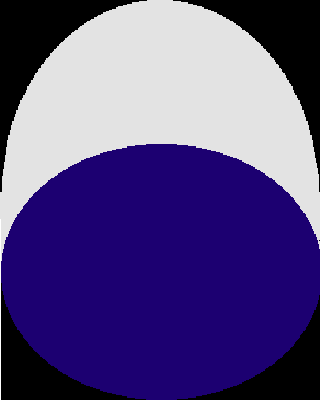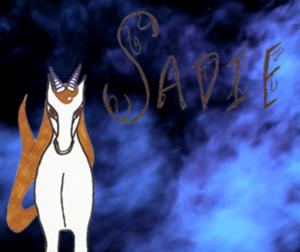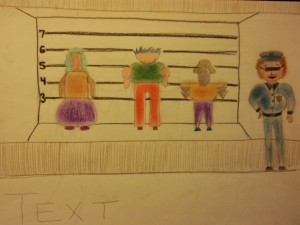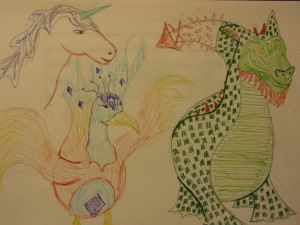Here is my final snowglobe game, if any of you are still checking the blog. To learn how to play, use the tutorial provided when you first open the game. If you want to start over for any reason, simply delete the savegame file that is automatically created when you exit the game. Here’s the link: http://www.andrew.cmu.edu/user/elazrus/Games/SnowGlobe2/
Author: elazrus
Final Project Progress
So I have the basic ecosystem that works within the snowglobe (as discussed last class with Paolo):
The girl starts outs in an “empty” snowglobe with no other objects besides the landscape. The “goal” of the game is to navigate the ecosystem and build her a house before she freezes. The basic mechanics are shaking the snowglobe to create a temporary “springtime”, picking up and dropping objects, planting seeds, and cutting trees. Shaking the globe to create the springtime will allow the player to find objects hidden under the snow such as seeds and sticks and rocks. The player has to balance building and maintaining a fire, planting and cutting down trees and building the house.
To further the snowglobe theme, I’ve decided to do away with the shelf room and have you simply double click on the game icon (which I will replace with the image of my snowglobe as I have bought the full license) to view into the snowglobe. This double clicking corresponds to shaking the snowglobe, so that each time you want to shake it you have to close the game and open it again. In this way, the snowglobe will sit on your desktop to look at whenever you want the same way a snowglobe would sit on your shelf. Eventually, once you have reached one of the two endings (building the house or the girl freezing), you will not be able to move the character when you open the game, you simply get to observe (like a real snowglobe). If you have built the house, the girl will appear and maybe wave while it is “springtime” and go back inside when the snow falls again. If you have left the girl freeze, you have essentially created a statue that never moves. To reset the game, you’d have to get rid of it and redownload it.
Lastly, I will still have the mechanic of zooming in further for a closer look at the girl. This will allow you to see how cold she is (the bluer her skin is the colder) and give you hints of what to do next in her thought bubbles.
So far I have been working to implement some of the new mechanics and have begun to work on the new artwork my final version requires. I have implemented the pick-up mechanic using a little blue ball as a test. You can try it out here: http://www.andrew.cmu.edu/user/elazrus/Games/SnowGlobe/ (the one that says pick_up_test). To pick up or drop an object use enter.
Final Project Prosposals
I have four ideas for what I would want to do for my final project:
1) Expand upon my first project in undum, by integrating the letters better into the story as per comments on my post, and by adding illustrations.
2) Expand upon my first project in renpy or gamemaker, and making it a point-and-click adventure. In this one, you would be able to travel through the different rooms of the house as different characters and you have to find all the letters.
3) Expand upon my fourth project which can be download here: http://www.andrew.cmu.edu/user/elazrus/Games/SnowGlobe/.
4) Pursue a new project that was inspired my my fourth project. I like the idea of needing to interact with the room(s) from both a zoomed in and zoomed out perspective, each of which corresponds to a different character. Instead of a snowglobe though I would use a doll house, so that you play as the little girl who’s doll house it is and as the dolls within the house. When you play as the girl, you can move around the furniture (and the dolls?) by pointing and clicking and when you play zoomed in as the doll(s), you interact with the different rooms using the keyboard, like with a platformer. I’m still debating if this game would be a puzzle game that had an actual goal/ending or if it would be more of a toy that you can play with as the two types of characters.
Assignment 4 – Snowglobe
Hi I know I’m super late with this but I got a late start and again started out with too big of a scope. Basically you play this character in a snowglobe and you have to learn how to sustain yourself. Right now what I have is two (really three) rooms: (1) you see the snowglobe on the shelf, (2) you see inside the snowglobe and (3) you see only what is immediately around the character.
You can use ‘z’ to zoom between the different rooms, ‘space’ to shake the snowglobe (shelf room), or make snowmen from piles of snow and make a campfire (other two rooms). If you want to try you can download the game here: http://www.andrew.cmu.edu/user/elazrus/Games/SnowGlobe/
I wanted to add in that the piles of snow only appear if you shake the snowglobe before zooming in (as well as snow on the trees and rocks and house and campfire), and that if you’re zoomed in for awhile the snow would start to melt. I have all the artwork for this just didn’t have the time to implement it. Also, I wanted to create status bars for hunger, rest, fun, and warmth that you can up by milking the cows/collecting eggs, going into the house, making snowmen, and making a fire, respectively.
Assignment 4
I haven’t made that much progress yet with assignment 4 due to having to finish projects for other classes but here is my basic idea: You are playing a girl who is living in a snow globe (though you don’t know it yet). You explore your world and are able to interact with other objects in it in different ways but are only able to do so very zoomed in so you don’t have a sense of the larger picture or the scale of the world. The landscape is all snow-covered and cold and it snowed on and off as you move (by someone shaking the snow globe). As you explore the world, you gain different skills and attire such as warm fur clothing, the ability to make your own food, a shelter where you can rest, etc. that help you better survive in the cold environment. Eventually (though I don’t know how or why yet) you realize that you are in this snow globe and the object of the game becomes trying to escape and live on your own independent of the world. I don’t have that much artwork yet but here is some of me playing around with pixel art:
I realize that some parts of this are really vague and the scope is kind of big but I’m think that this is what I will want to work on for my final project so I’m hoping to get a small version done for assignment four and the whole game done for the final.
Also this is what I’m thinking about for my music: http://www.youtube.com/watch?v=O8MXw3Md9FI
Readings
1) Transit
Transit brought a very interesting idea to the surface; that of the differences in experiencing space through different modes of travel. The author argues that as technology makes it possible to travel faster and at different elevations (on the ground versus in the air, etc.), our experience of discovering space, particularly that “in-between” space between start in destination, has radically changed. Further, he argues that the worlds created in video games bring us backwards in time by forcing us to discover these new worlds in the same way we discovered our world before technology. I agree with this to an extent, and this makes it interesting to reflect on the “technologies” we have created to deal with these video game worlds. Initially, it is true that gamers had to learn to traverse these new terrains on their own, but eventually tools were developed to help make this job easier. For almost every big box video game nowadays, you can purchase a strategy guide or find an online walkthrough that lets you understand the game’s world before you discover it for yourself through the use of photographs, videos, or aerial views. You still have the option to play on your own through complete discovery, but you also have the option to traverse the world more quickly using these tools. Of course, this is true in real life too; no one is forcing you to drive a car, or take an airplane or a ship – it just make it a lot easier and quicker (or provides a way that never existed before, in the case of traveling over water) to get to another part of the world. You can still explore places you have never been before by walking without using google maps – this is what hikers do all the time. The difference between now and before we had technology is that we had no choice but to explore in the ways we did. Taking all of this into account, I would argue that the worlds of video games don’t bring us back to a past time, but rather mirror the way we look at travel and exploration in the real world: we can choose to explore on our own but we have tools to help make this exploration easier.
2) Game Design As Narrative Architecture and Narrative Environments From DisneyLand to World of Warcraft
I found this idea of Narrative Architecture in games particularly intriguing, especially coming from an architecture background. In my experience it seems that the definition of architecture varies depending on who you talk to, and as such I have developed my own understanding which, simply put, is the expression of an idea through through spatial experience. In this way, I think that the environment of a game can definitely influence the understanding of the game. The first of the two articles describes four possible ways that the environment of a game can be integrated with game play. I think that these four can be further categorized into two simple characterizations: 1) games where the environment enhances gameplay, and 2) games where the environment is inherit to gameplay. To me, the latter is the more interesting of the two and it brings me back to an open-ended question I began thinking about when I made the transfer from architecture to BCSA: how can we use virtual environment to create experiences that cannot be created in the built environment? I think the answer(s) to this question can be explored and tested by creating these type 2 games.
Black World (Assignment 3)
You can play my assignment 3 here: http://www.andrew.cmu.edu/user/elazrus/Black%20World/blackWorld_v2.swf
There are a few things I would like to go back and add/fix to make the world more consistent but this is the gist of it. For instance, I would like to have the cloud in the water move with the other reflected items and I’d like to find a way to make the game playable without the forced lateral movements and the outlines (I could just make the outlines invisible but I don’t think that would really help that much because the movements would still be very orthogonal). Any suggestions for improvement are welcome.
Sadie
A little late but here it is: http://www.andrew.cmu.edu/user/elazrus/Sadie-1.0-dists/
Assignment 3 Proposal
The game I am proposing is a combination of point-and-click and platformer. The world is very simple with few colors and simple shapes that is made up of a series of levels moving upward. The player plays a stick-figure wizard who has the magic to manipulate geometric primitive to do his bidding. On each level, the player must do two things: 1) figure out how to manipulate the geometry to result in turning on the lights for the above platform, and 2) figure out how to manipulate the geometry again to reach the above platform. The wizard wants to get to the top for some reason or another (haven’t quite fleshed that out yet).
Example: The player starts out with a single line (maybe his wand?) which he has to spin really fast until it forms a circle, rolls down the fill, and hits the button, turning on the lights for the above level. Then he must enlarge the circle until he realizes that it is not a circle, but rather a 16-gon. Then he can connect all opposite vertices and create a ladder that he can climb up to the second level.
Visual Story Ideas
1) What Did You Witness?
For this idea I was inspired by Paolo’s demonstration in class of creating characters from manipulated simple shapes. But in this case, the player will be “designing” the character. The game starts off with a pixelated background of a dark alley, a building, and a vague silhouetted figure. Then Policeman Bob will show up to inform you that you have just witnessed a crime and need to describe the perp. Policeman Bob will ask questions relating to the perp’s physical appearance, specifically: lower body type (boxy, round, v-shaped), lower body size (long, squat, proportional), upper body type (boxy, round, v-shaped), upper body size (long, squat, proportional), head shape (oval, rectangular, heart-shaped), head size (long, squat, proportional), gender, skin color, hair color, hair type (curly, straight, wavy), hair length (long, short, shoulder-length), clothing color, and shoe color. At the end, the player will brought to the police station to identify the perp they described. The player “wins” if he found identified the correct criminal.
2) Enchanted Wilderness
In this game, the player would be hiking and stumble under an “enchanted” forest with legendary animals. He then gets to choose which animal he wants to follow and learn about , make friends with, or capture. The three animals he can follow are a dragon, a unicorn, or a phoenix. I want each of the three characters to have unexpected qualities: for instance, if the player decides to follow the unicorn, he always views it from the profile, and at the end he sees it head-on and it actually has two horns and is an evil, devil-type character.





